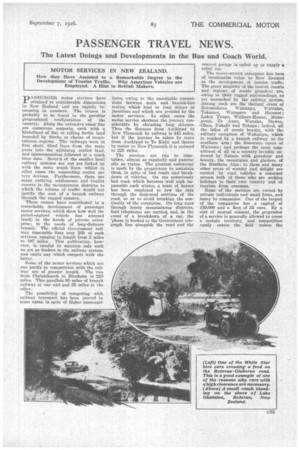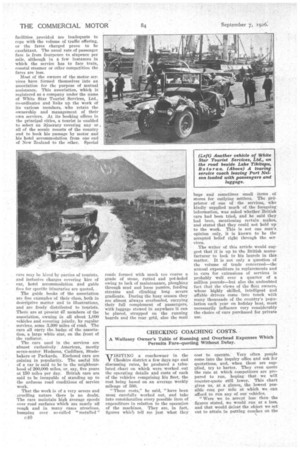PASSENGER TRAVEL NEWS.
Page 61

Page 62

If you've noticed an error in this article please click here to report it so we can fix it.
The Latest Doings and Developments in the Bus and Coach World.
MOTOR SERVICES IN NEW ZEALAND.
How they Have Assisted to a Remarkable Degree in the Development of Tourist Traffic. Why American Vehicles are Employed. A Hint to British Makers.
pASSENGER motor services have attained to considerable dimensions in New Zealand ;and are rapidly in: creasing in numbers. The reason is probably to be found in the peculiar geographical configuration of the country, Along the extensive coast line are numerous seaports, each with a hinterland of flat or rolling fertile laud bounded by blocks or chains of mountainous regions. The railways were at first short, blind. lines from the main ports into the adjoining settled land, and interconnection followed at a much later date. Several of the smaller local railway systems are not yet linked up with the main trunk lines, whilst in other eases the connecting routes are very devious. Furthermore, there are many outlying settlements and tourist resorts in the mountainous districts to which the volume of traffic would not justify the cost of a branch railway through the rugged country.
• 'These causes have contributed to a remarkable development of passenger motor services, which show how well the petrol-engined vehicle has adapted itself, in the hands of private enterprise, to the needs of long-distance transit. The official Government railway time-table lists over 200 of such services, ranging in length from 2 miles to 195 miles. This publication, however, is careful to mention only such as act as feeders to the railway system, and emits any which compete with the latter.
Some of the motor services which are run partly in competition with the railway are of greater length. The run from Christchurch to Blenheim is 22,5 miles. This parallels 55 miles of branch railway at one end and 2,S miles at the other.
The possibility of competing with railway transport has been proved in some cases, in spite of higher passenger
fares, owing to the unsuitable connections between main and branch-line trains, which lead to long delays at junctions and which are avoided by the motor services. In other cases the motor service shortens the journey considerably by obviating long detours. Thus the distance from Auckland to New Plymouth by railway is 445 miles, but if the journey be taken by train from Auckland to Te Kuiti and thence by motor to New Plymouth it is reduced to 225 miles.
The services are run to timetables, almost as regularly and punctually as trains. The greatest endeavour is made by the proprietors to maintain them, in spite of bad roads and breakdown of vehicles. On one notoriously bad road, which becomes well nigh impassable each winter, a team of horses has been employed to tow the cars through the deep-mud sections of the road, so as to avoid breaking the continuity of the enterprise. On long runs through lonely mountainous districts, field telephones are carried, and, in the event of a breakdown of a car, the 'phone is hooked to the Government telegraph line alongside the road and the nearest garage is called up to supply a relief car.
The motar-service enterprise has been of inestimable value to New Zealand in the development of tourist traffic. The great majority of the tourist resorts and regions of scenic grandeur are, owing to their rugged surroundings, as yet unreaehed by the railway system. Among such are the thermal areas of Rotomahana, Waiotapu, Wairakei, Tokaauu, Waingaro and Harmer ; Lakes Taupo, Waikare-Moana, Mann.pouri, Te Auau, Wanaka, .0hau, Pukaki and Tekapo ; indeed, all the lakes of scenic beauty, with the • solitary exception of Wakatipu, which is reached by a branch railway on its southern arm ; the limestone caves of Waitomo; and perhaps the most magnificent of all in a country lavishly endowed by Nature with grandeur and beauty, the mountains and glaciers of the Southern Alps: to these and many other areas of wonder and delight are carried by road vehicles a constant stream both of those who are seeking holidays in their own country and of tourists from overseas.
Some of the services are owned by private individuals and small firms, and many by companies. One of the largest of the companies has a capital of £50,000 and a fleet of 55 ears. By a sort of mutual consent, the proprietor of a service is generally allowed to cover
eertain territory, and competition rarely enters the field unless the
facilities provided are inadequate to cope with the volume of traffic offering, or the fares charged prove to be exorbitant. The usual rate of passenger fare is from fourpence to sixpence per mile, although in a few instances in which the service has to face train, coastal steamer or other competition the fares are less.
Alost of the owners of the motor services have formed themselves into an association for the purpose of mutual assistance. This association, which is registered as a company under the name of White Star Tourist Services, Ltd., co-ordinates and links up the work of its various members, _who retain the ownership and management of their own services. At its booking offices in the principal cities, a tourist is enabled to select an itinerary covering any or. all of the scenic resorts of the country and to book his passage by motor and his hotel accommodation from one end of New Zealand to the other. Special cars may be hired by parties of tourists, and inclusive charges covering hire of car, hotel accommodation and guide fees for specific itineraries are quoted.
The guide books of the association are fine examples of their class, both in descriptive matter and in illustrations, and are freely distributed to tourists. There are at present 47 members of the association, owning in all about 1,400 vehicles and covering jointly, by regular services, some 3,300 miles of road. The ears all carry the badge of the association, a large white star, on the front of the radiator. .
The cars used in the services are almost exclusively. American, mostly seven-seater. Hudsons, Cadillacs, Stade. bakers or Packard%Enclosed cars are gaining in popularity. The useful life of a car is said to be in the neighbourhood of 200,000 miles, or, say, five years at 150 miles per day. British cars are said to be incapable of standing up to the arduous road conditions of service work.
That the work is of a very severe and gruelling nature there is no doubt. The cars maintain high average siiceds over road surfaces which are nearly all rough and in many cases atrocions, bumping over so-called "metalled " roads formed with much too coarse a grade of stone, rutted and pot-holed owing to lack of maintenance, ploughing through mud and loose pumice, fording streams and climbing long severe gradients. During the busy season they are almost always overloaded, carrying their full complement of passengers, with luggage stowed in anywhere it can he placed, strapped on the running boards and the rear grid, also the mail bags and sometimes small items of stores for outlying settlers. The proprietor of one of the services, who kindly supplied much of the foregoing information, was asked whether British cars had been tried, and he said they had been, mentioning certain makes, and stated that they could not hold up to the work. This is not one man's opinion only, it is known to be the accepted belief right through the ser vices.
The writer of this article would suggest that it is up to the British manufacturer to look to his laurels in this matter. It is not only a question of the volume Of trade concerned—the annual expenditure in replacements and in cars for extensions of services is probably well over a quarter of a million pounds—but also the undoubted fact that the views of the fleet owners, whose highly skilled, intelligent and affable drivers come into touch with many thousands of the country's population each year on holiday bent, must necessarily influence very considerably the choice of cars purchased for private use.












































































































